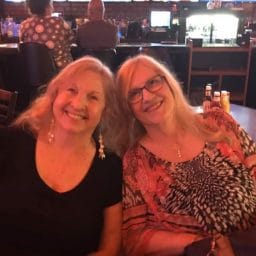By Javia Headley, Marketing Communications Manager
When Darlene Fragale first started losing her hearing in the 1960s, there were not many options for otosclerosis patients like her to regain their sense of sound. Otosclerosis occurs when a middle ear bone grows abnormally, disrupting the path sound would travel. Darlene was in her thirties when she first started losing her hearing. Fifteen years later her hearing loss would become profound. In an era where resources for the deaf seemed finite, Dr. William House, MD, stepped into her life and offered her another choice.

It was 1979 when Darlene came into the House Ear Clinic for her first appointment with Dr. William House. At that time, Dr. House had just started the clinical trial for the single-channel cochlear implant, the first device of its kind. Darlene recalls fondly the moment Dr. House told her of this new device that could help her regain her hearing. Unaware of the months of audiological and psychological testing ahead, she immediately asked, “Can we do the surgery next week?”
In November of 1979, Dalene became one of the first patients in the cochlear implant clinical trial. Six months later, Dr. William House offered her a job at the House Ear clinic as an X-ray technician. By accepting this opportunity, Darlene was uniquely positioned to not only mentor cochlear implant candidates but also to observe and experience how much the lives of the deaf and hard of hearing would change throughout her 32-year career with our institution.
At a time when watching TV required a decoder for captions and communicating via telephone typewriters was a long and arduous process, the cochlear implant came as a miracle to many individuals. Just being able to sit and carry on a conversation was a luxury that many thought they would never experience again.
Today, Darlene’s daughter and grandson share the same disease that first began affecting her hearing in the ’60s, but technology has progressed substantially since then. Television channels all have closed captioning, and messaging apps offer a smoother way to communicate for those who cannot carry on phone conversations. Even cochlear implants have significantly advanced. In 1989, Darlene had her opposite ear implanted with the multichannel successor to Dr. House’s first-generation implant. In 2010, her original ear was upgraded to match.
When asked for the most memorable moment in her 50-year journey with hearing loss, Darlene recalled November 1989. Just days before Thanksgiving, she met with House Institute audiologist, Dr. Dawna Mills, Au.D., to ask if her new, multichannel cochlear implant could be activated early. Thanksgiving Day found her driving 300 miles to visit her daughter. She stopped at a gas station and a man standing about 15 feet away called out and asked, “Did you buy that car locally?” It was not until after she had responded affirmatively and driven away that Darlene realized she had been able to hear without lipreading for the first time in almost thirty years.
As a new generation of accessibility and technology for the deaf and hard of hearing is ushered in, Darlene wants new cochlear implant users to remember that attitude is everything; even the little things can bring you immense joy. “It’s a lot easier to fry bacon when you can hear it!” Darlene joked. “Not many people think about that.”
